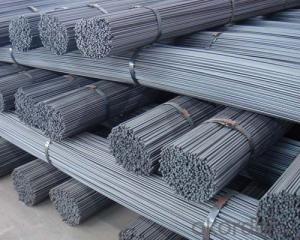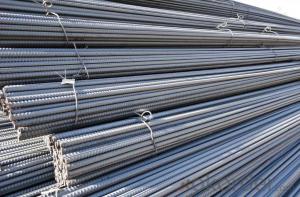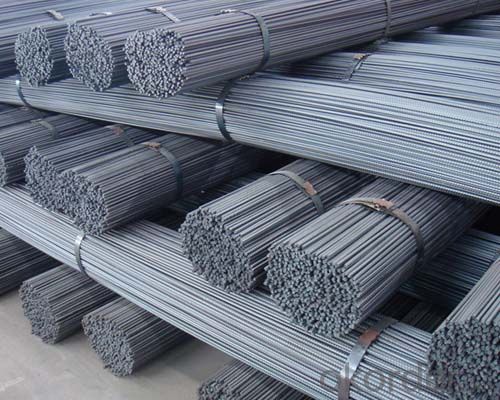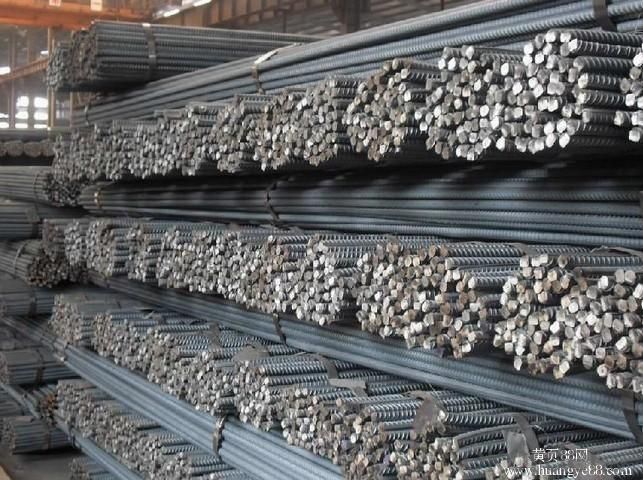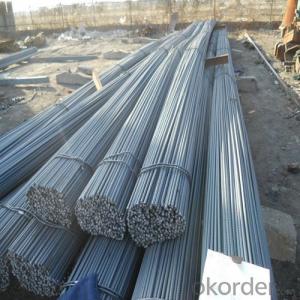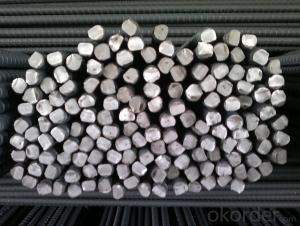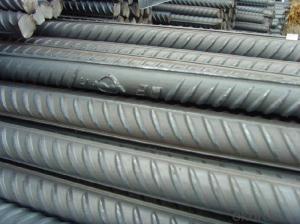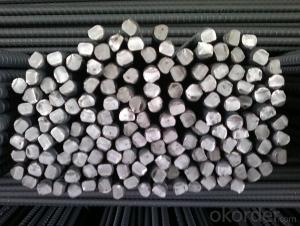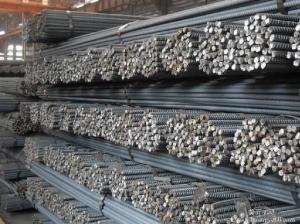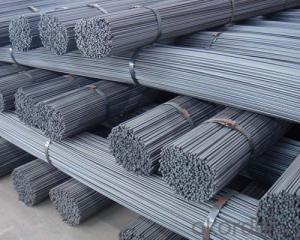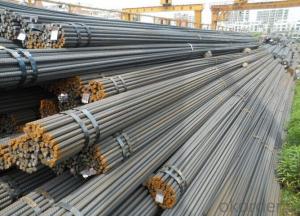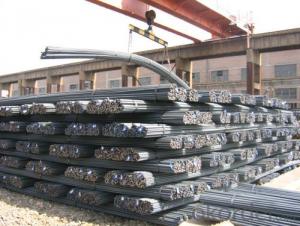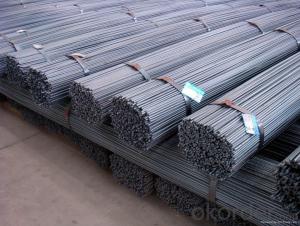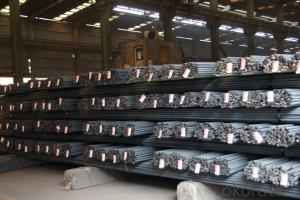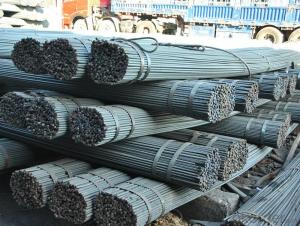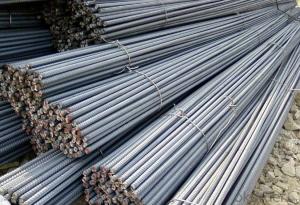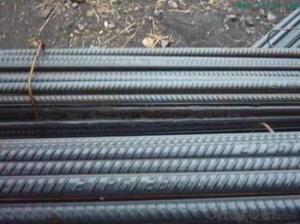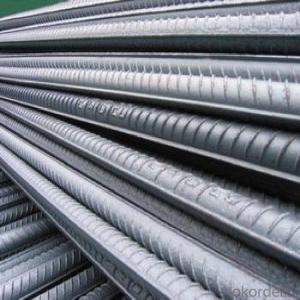Deformed bars in Grade HRB400 with Best Quality
- Loading Port:
- Tianjin
- Payment Terms:
- TT OR LC
- Min Order Qty:
- 25 m.t.
- Supply Capability:
- 100000 m.t./month
OKorder Service Pledge
OKorder Financial Service
You Might Also Like
Product Description:
Specifications of HRB400 Deformed Steel Bar:
Standard | GB | HRB400 | |
Diameter | 6mm,8mm,10mm,12mm,14mm,16mm,18mm,20mm, 22mm,25mm,28mm,32mm,36mm,40mm,50mm | ||
Length | 6M, 9M,12M or as required | ||
Place of origin | Hebei, China mainland | ||
Advantages | exact size, regular package, chemical and mechanical properties are stable. | ||
Type | Hot rolled deformed steel bar | ||
Brand name | DRAGON | ||
Chemical Composition: (Please kindly find our chemistry of our material based on HRB500 as below for your information)
Grade | Technical data of the original chemical composition (%) | ||||||
C | Mn | Si | S | P | V | ||
HRB400 | ≤0.25 | ≤1.60 | ≤0.80 | ≤0.045 | ≤0.045 | 0.04-0.12 | |
Physical capability | |||||||
Yield Strength (N/cm²) | Tensile Strength (N/cm²) | Elongation (%) | |||||
≥400 | ≥570 | ≥14 | |||||
Theoretical weight and section area of each diameter as below for your information:
Diameter(mm) | Section area (mm²) | Mass(kg/m) | Weight of 12m bar(kg) |
6 | 28.27 | 0.222 | 2.664 |
8 | 50.27 | 0.395 | 4.74 |
10 | 78.54 | 0.617 | 7.404 |
12 | 113.1 | 0.888 | 10.656 |
14 | 153.9 | 1.21 | 14.52 |
16 | 201.1 | 1.58 | 18.96 |
18 | 254.5 | 2.00 | 24 |
20 | 314.2 | 2.47 | 29.64 |
22 | 380.1 | 2.98 | 35.76 |
25 | 490.9 | 3.85 | 46.2 |
28 | 615.8 | 4.83 | 57.96 |
32 | 804.2 | 6.31 | 75.72 |
36 | 1018 | 7.99 | 98.88 |
40 | 1257 | 9.87 | 118.44 |
50 | 1964 | 15.42 | 185.04 |
Usage and Applications of HRB400 Deformed Steel Bar:
Deformed bar is widely used in buildings, bridges, roads and other engineering construction. Big to highways, railways, bridges, culverts, tunnels, public facilities such as flood control, dam, small to housing construction, beam, column, wall and the foundation of the plate, deformed bar is an integral structure material. With the development of world economy and the vigorous development of infrastructure construction, real estate, the demand for deformed bar will be larger and larger..
Packaging & Delivery of HRB400 Deformed Steel Bar:
Packaging Detail: products are packed in bundle and then shipped by container or bulk vessel, deformed bar is usually naked strapping delivery, when storing, please pay attention to moisture proof. The performance of rust will produce adverse effect.
Each bundle weight: 2-3MT, or as required
Payment term: TT or L/C
Delivery Detail: within 45 days after received advanced payment or LC.
Label: to be specified by customer, generally, each bundle has 1-2 labels
Trade terms: FOB, CFR, CIF
- Q: What is the national standard of thread steel No. 8?
- Thread steel specifications: generally including the standard grade (type code), steel nominal diameter, nominal weight (quality), the length of the specifications and the allowable difference between the above indicators. China's standard recommended nominal diameter of 6, 8, 10, 12, 16, 20, 25, 32, 40, 50mm thread steel series.
- Q: Are steel rebars available in different shapes and profiles?
- Yes, steel rebars are available in different shapes and profiles. The most common shape of steel rebars is the plain round bar, which is circular in shape and has a smooth surface. However, there are also other shapes and profiles available such as deformed bars, which have ribs or indentations along their length. These ribs provide better adhesion between the rebars and the surrounding concrete, increasing the overall strength and stability of the structure. Additionally, steel rebars can be found in various sizes and lengths to suit different construction needs. Some examples of different profiles include square bars, flat bars, and T-shaped bars. These various shapes and profiles provide flexibility and options for engineers and builders to choose the most suitable type of steel rebar for their specific construction projects.
- Q: Can steel rebars be used in the construction of hospitals and healthcare facilities?
- Yes, steel rebars can be used in the construction of hospitals and healthcare facilities. Steel rebars provide strength, durability, and resistance to corrosion, making them suitable for reinforcing concrete structures in these critical facilities. They ensure structural integrity and enhance the overall safety and longevity of the buildings, meeting the stringent requirements and codes set for healthcare infrastructure.
- Q: How do steel rebars contribute to the load-bearing capacity of concrete slabs?
- Steel rebars contribute to the load-bearing capacity of concrete slabs by providing reinforcement and increasing the overall strength and durability of the structure. As concrete is strong in compression but weak in tension, steel rebars are embedded within the concrete to counteract tension forces. The rebars absorb and distribute the tensile stresses, preventing the concrete from cracking or failing under heavy loads. This combination of concrete and steel rebars creates a reinforced structure that can bear more weight and withstand various external forces, ensuring the integrity and safety of the concrete slab.
- Q: Can steel rebars be used in structures with limited construction timeframes?
- Structures with limited construction timeframes can indeed utilize steel rebars. These rebars are frequently employed in construction projects due to their remarkable tensile strength, making them ideal for reinforcing concrete structures. Speedy and efficient installation is achievable with steel rebars, enabling faster construction compared to alternative reinforcement materials. Moreover, steel rebars offer durability and long-term stability, guaranteeing the integrity of the structure, even in time-constrained projects. Hence, employing steel rebars proves to be an effective solution for structures with limited construction timeframes, as they deliver both strength and swiftness in the construction process.
- Q: Laiwu steel thread steel trademark color blue and red Qu Qu
- It is suggested that the users must obtain the certificate of quality of steel when they buy the thread steel, and check and accept it. For quality problems, the quality inspection and inspection can be carried out at the professional inspection organization.
- Q: Can steel rebars be used in industrial flooring?
- Yes, steel rebars can be used in industrial flooring. Steel rebars provide added strength and reinforcement to concrete structures, making them suitable for heavy-duty applications such as industrial flooring. The rebars are typically embedded within the concrete to increase its load-bearing capacity and prevent cracking or structural failure.
- Q: Can steel rebars be used in the construction of tunnels?
- Yes, steel rebars can be used in the construction of tunnels. Steel rebars are commonly used as reinforcement in concrete structures, including tunnels. They provide strength and stability to the concrete, making it capable of withstanding the loads and stresses experienced in tunnel construction.
- Q: How are steel rebars protected against mechanical damage during construction?
- Steel rebars are protected against mechanical damage during construction through various methods. One common method is by using protective covers or sleeves made of materials such as plastic or rubber. These covers are placed over the rebars to create a physical barrier, preventing them from being directly exposed to potential sources of damage, such as heavy machinery or construction equipment. Another method of protection is by using rebar caps or safety caps. These caps are designed to fit over the ends of the rebars, providing an extra layer of protection against mechanical damage. They help to prevent the rebars from being bent, crushed, or damaged by accidental impacts. In addition to physical protection, rebars can also be protected against mechanical damage through proper storage and handling. It is important to store rebars in a designated area that is free from any potential sources of damage, such as sharp objects or heavy materials. When handling rebars, workers should use proper lifting techniques and avoid dragging them on rough surfaces, as this can cause scratches or other forms of damage. Furthermore, during construction, rebars are often inspected regularly to ensure that they are not damaged or compromised. Any rebars that show signs of damage, such as bends, cracks, or deformations, are typically replaced to maintain the structural integrity of the construction project. By implementing these protective measures, steel rebars can be safeguarded against mechanical damage during construction, ensuring their effectiveness in providing strength and reinforcement to the structures they are used in.
- Q: Can steel rebars be used in foundation systems?
- Steel rebars have the ability to be utilized in foundation systems. These reinforcing bars, alternatively referred to as steel rebars, are frequently employed in concrete structures to bolster their durability and strength. Within foundation systems, steel rebars serve the purpose of reinforcing the concrete and averting any potential cracking or failure. Typically, they are embedded within the concrete to heighten its tensile strength and enhance its resistance to various external forces like bending, shearing, and tension. In order to ensure the stability and longevity of structures, steel rebars are extensively employed in a variety of foundation systems, ranging from shallow foundations to deep foundations and pile foundations.
Send your message to us
Deformed bars in Grade HRB400 with Best Quality
- Loading Port:
- Tianjin
- Payment Terms:
- TT OR LC
- Min Order Qty:
- 25 m.t.
- Supply Capability:
- 100000 m.t./month
OKorder Service Pledge
OKorder Financial Service
Similar products
Hot products
Hot Searches
Related keywords
